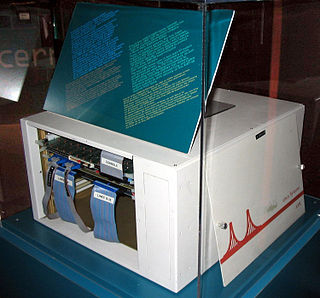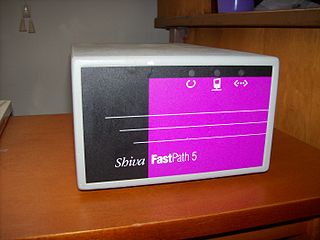This page is based on this
Wikipedia article Text is available under the
CC BY-SA 4.0 license; additional terms may apply.
Images, videos and audio are available under their respective licenses.
Internetworking is "the concept of interconnecting different types of networks to build a large, global network" such that any pair of connected hosts can exchange packets. To build an internetwork, the following are needed: A standardized scheme to address packets to any host on any participating network; a standardized protocol defining format and handling of transmitted packets; components interconnecting the participating networks by routing packets to their destinations based on standardized addresses.

A local area network (LAN) is a computer network that interconnects computers within a limited area such as a residence, school, laboratory, university campus or office building. By contrast, a wide area network (WAN) not only covers a larger geographic distance, but also generally involves leased telecommunication circuits.
In computer networking, Point-to-Point Protocol (PPP) is a data link layer communications protocol used to establish a direct connection between two nodes. It connects two routers directly without any host or any other networking device in between. It can provide connection authentication, transmission encryption, and compression.

A router is a networking device that forwards data packets between computer networks. Routers perform the traffic directing functions on the Internet. Data sent through the internet, such as a web page or email, is in the form of data packets. A packet is typically forwarded from one router to another router through the networks that constitute an internetwork until it reaches its destination node.

Packet switching is a method of grouping data that is transmitted over a digital network into packets. Packets are made of a header and a payload. Data in the header are used by networking hardware to direct the packet to its destination where the payload is extracted and used by application software. Packet switching is the primary basis for data communications in computer networks worldwide.
The Routing Information Protocol ('RIP') is one of the oldest distance-vector routing protocols which employ the hop count as a routing metric. RIP prevents routing loops by implementing a limit on the number of hops allowed in a path from source to destination. The largest number of hops allowed for RIP is 15, which limits the size of networks that RIP can support.
Network address translation (NAT) is a method of remapping one IP address space into another by modifying network address information in the IP header of packets while they are in transit across a traffic routing device. The technique was originally used as a shortcut to avoid the need to readdress every host when a network was moved. It has become a popular and essential tool in conserving global address space in the face of IPv4 address exhaustion. One Internet-routable IP address of a NAT gateway can be used for an entire private network.
An application layer is an abstraction layer that specifies the shared communications protocols and interface methods used by hosts in a communications network. The application layer abstraction is used in both of the standard models of computer networking: the Internet Protocol Suite (TCP/IP) and the OSI model. Although both models use the same term for their respective highest level layer, the detailed definitions and purposes are different.
Fuzzball routers were the first modern routers on the Internet. They were DEC LSI-11 computers loaded with the Fuzzball software written by David L. Mills. The name "Fuzzball" was the colloquialism for Mills' routing software. Six Fuzzball routers provided the routing backbone of the first 56 kbit/s NSFnet, allowing the testing of many of the Internet's first protocols. It allowed the development of the first TCP/IP routing protocols, and the Network Time Protocol. They were the first routers to implement key refinements to TCP/IP like variable-length subnet masks.
AppleTalk Remote Access, or ARA, was a protocol stack that allowed AppleTalk to be run over modems. It became a fairly major product for Apple Computer in the early to mid-1990s when their first portable and laptop computers were available. ARA slowly disappeared in the late 1990s when TCP/IP took over the vast majority of networking needs, notably remote access.
Packet loss occurs when one or more packets of data travelling across a computer network fail to reach their destination. Packet loss is either caused by errors in data transmission, typically across wireless networks, or network congestion. Packet loss is measured as a percentage of packets lost with respect to packets sent.

Radia Joy Perlman is an American computer programmer and network engineer. She is most famous for her invention of the spanning-tree protocol (STP), which is fundamental to the operation of network bridges, while working for Digital Equipment Corporation. She also made large contributions to many other areas of network design and standardization, such as link-state routing protocols.

The Kinetics FastPath was a MacIP to TCP/IP router created in 1985 to allow Apple Macintosh computers to communicate with other computers on Ethernet networks. The product had five significant revisions during its lifetime and was sold by Shiva Networks late in its existence. The FastPath itself was modeled after an implementation of the Stanford Ethernet - AppleTalk Gateway (SEAGATE) created at Stanford University Medical Center by Bill Croft in 1984 and 1985. SEAGATE was a combination of hardware and software that picked up IP packets from the Ethernet network and encapsulated them inside of DDP packets on the AppleTalk network and conversely picked up specially-encoded DDP packets on the AppleTalk network and placed them on the Ethernet network as IP packets.
A LocalTalk-to-Ethernet Bridge is a network bridge that joins the physical layer of the AppleTalk networking used by previous generations of Apple Computer products to an Ethernet network. This was an important class of products in the late 1980s and early 1990s, before Ethernet support became universal on the Mac lineup.
TOPS is a peer-to-peer LAN-based file sharing system best known in its Macintosh implementation, but also available for Windows and able to interoperate with Unix's NFS. Originally written by Centram Systems West, the company was purchased by Sun Microsystems as part of Sun's development of the NFS ecosystem. Sales of TOPS dried up after the introduction of System 7, which featured a similar file sharing system built-in, and Sun spun off their NFS developments to Sitka.
In telecommunication, a communication protocol is a system of rules that allow two or more entities of a communications system to transmit information via any kind of variation of a physical quantity. The protocol defines the rules, syntax, semantics and synchronization of communication and possible error recovery methods. Protocols may be implemented by hardware, software, or a combination of both.
Routing and Remote Access Service (RRAS) is a Microsoft API and server software that makes it possible to create applications to administer the routing and remote access service capabilities of the operating system, to function as a network router. Developers can also use RRAS to implement routing protocols. The RRAS server functionality follows and builds upon the Remote Access Service (RAS) in Windows NT 4.0. RRAS was introduced with Windows 2000 and offered as a download for Windows NT 4.0.




